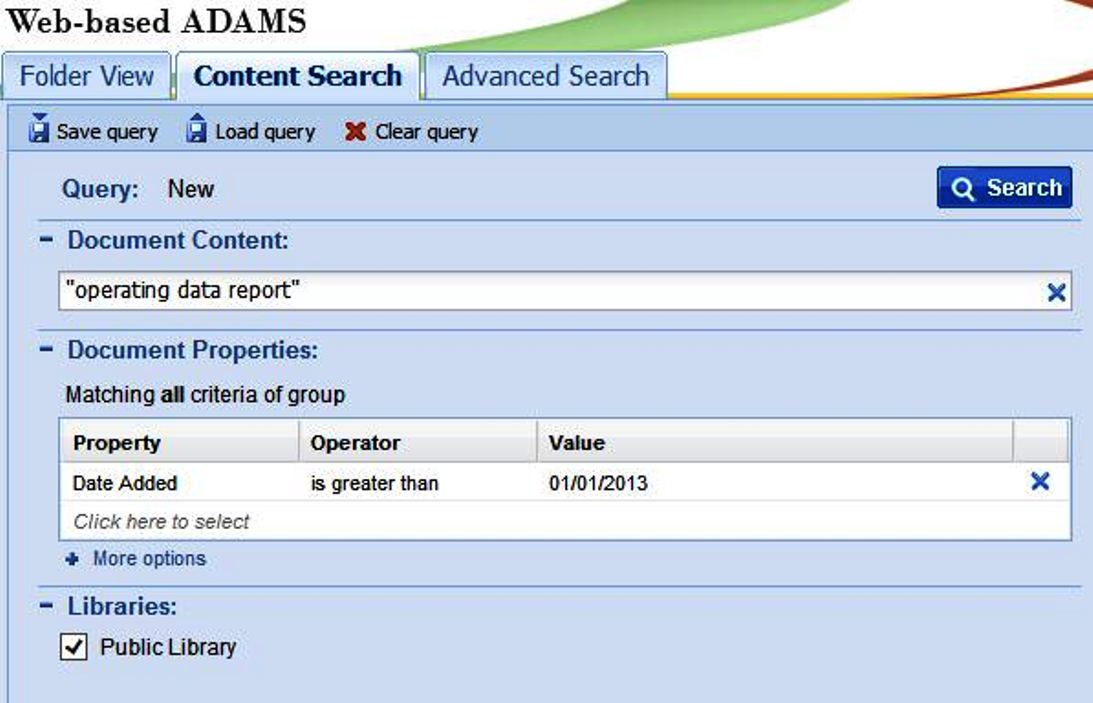NEAT #6 described the daily power level information available on the Nuclear Regulatory Commission’s website. That data shows times when reactors are shut down and operating at less than full power, but it doesn’t explain why it is happening. Monthly operating reports are available online that often contain the explanations.
The monthly operating reports are in the NRC’s online electronic library, ADAMS. (Please don’t tell the U.S. Supreme Court about this aspect of our post. They have this thing against cruel and unusual punishment and tossing people into ADAMS just might upset them.)
Here’s a way to retrieve recent monthly operating reports:
- Go to the NRC’s ADAMS portal (we’re sorry)
- Click on Begin Web-Based ADAMS Search to enter ADAMS (we’re sorry)
- Click on the Content Search tab to the upper left (we’re sorry)
- Enter “operating data report” in quotes in the Document Content box
- Click on the right end of the first box under the Property column to activate a pull-down menu and select Date Added from its options
- Click on the right end of the first box under the Operator column to activate a pull-down menu and select is greater than
- Enter a date in month/day/year format in the first box under the Value column (it is recommended that a date at least three months ago be entered)
- Click the Search icon
- The documents will appear on the panel to the right and can be viewed or downloaded to your computer
- Each document contains one quarter of Operating Data Reports for all nuclear power reactors licensed to operate in the United States
- Exit ADAMS (much more rewarding than cheese at the end of a maze!)
Each monthly operating report contains statistical information like the number of hours the report was critical, the number of hours the generator was connected to the electrical grid, and the net amount of electricity generated by the reactor for that month, the year to date, and cumulative over the reactor’s entire lifetime.
In addition, the monthly operating reports explain the reason and duration of each reactor shut down. Optionally, owners can also report why the reactor power level was reduced during the month (e.g., to conduct tests or as a precautionary measure during severe weather).
The monthly operating reports can provide the reasons why reactors did not operate at full power. A drawback is that these reasons lag real time by one to four months. For example, the monthly reports for January are included within the first quarter reports that the NRC posts in ADAMS typically in early May. (The owners provide the monthly data to the Institute for Nuclear Power Operations (INPO) which in turn provides quarterly packages to the NRC.)
Any consequences from this delay are mitigated by more immediate reporting systems. The event notification system and the licensee event reporting system require public reports within days and two months respectively when serious problems cause reactors to shut down or reduce their power levels. The monthly operating reports supplement these reporting systems by providing fuller information about other events. The monthly operating reports also explain how long it took to restart or recover from incidents initially reported by the other systems.
Bottom Lines
The information contained in the monthly operating reports never rivals paperback novels for beach reading. But they can be more useful than paperback novels when seeking additional reasons for why a reactor shut down or operated at reduced power. The monthly operating reports can provide useful insights into when reactors normally reduce power for testing and other activities so as to help differentiate between same old, same old and something new.
The UCS Nuclear Energy Activist Toolkit (NEAT) is a series of post intended to help citizens understand nuclear technology and the Nuclear Regulatory Commission’s processes for overseeing nuclear plant safety.

